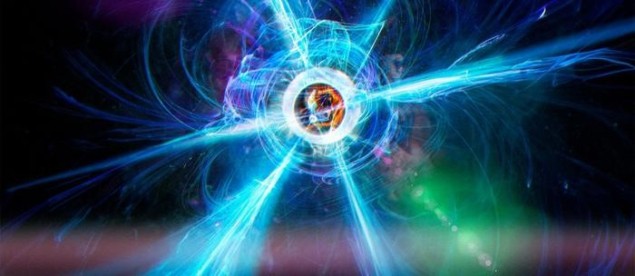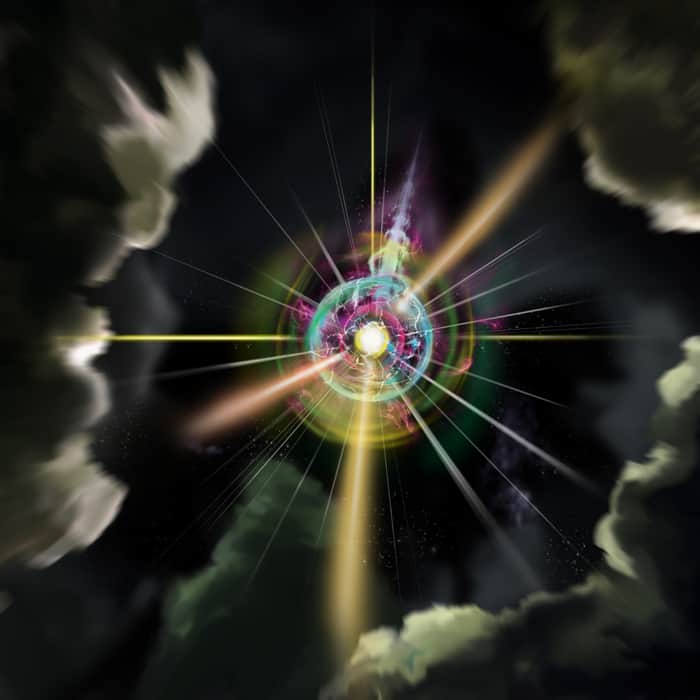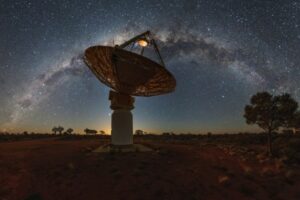
In Lewis Carroll’s novel, Through the Looking-Glass, Alice encounters a mirror-like portal to a world where rules of reality are reversed. In the 1980s, the story inspired the name for a ring-like vortex, which is predicted to emerge as monopoles decay. This “Alice ring” then flips the charges of any other monopoles that pass through it.
Now, for the first time, these Alice rings have been observed in the lab by researchers in the US and Finland. Their experiment involves ultracold atoms and it could shed light on fundamental processes in particle physics and cosmology.
The team’s discovery draws from two lines of research that both emerged about 35 years ago. One is the concept of “cosmic strings”, which describe 1D defects in the fabric of space–time. Although hypothetical, the existence of such strings would have profound implications for cosmology.
“The idea of a cosmic string is that, if you were to travel around it, would turn you from matter to antimatter (or vice versa),” explains David Hall at Amherst College, who headed the experimental part of the project with Alina Blinova as the final part of her PhD thesis. “If it were to exist, such a cosmic string would be known as an ‘Alice string’.”
Singular points of charge
The second line of research involves monopoles, which are singular points of charge in space. Both monopoles and strings could carry conserved topological charges, which could be magnetic, electric, or quark colour charges.
“In the 1980s, we realized that such a monopole could become deformed in a curious way,” Hall explains. “Far from its centre it still looks like a monopole, but if you got in close you wouldn’t see the point singularity but rather an Alice ring, which is a loop of Alice string that is closed on itself.”
One particularly striking property of an Alice ring is that if another monopole somehow managed to pass through its middle, the monopole would transform from a particle into an antiparticle. This means that by looking through the ring, much like Alice and her looking glass, we are essentially viewing a mirrored universe where antimatter dominates over matter.
In 2015, a breakthrough came when a team of Hall’s collaborators created a monopole in a Bose–Einstein condensate. This was a gas of rubidium atoms cooled close to absolute zero, where quantum properties can be observed on the macroscopic scale.
Precision control
“Our technique relied on precision control of magnetic fields to create the initial monopole,” Hall explains.
In their latest study, Hall and Blinova’s team combined this experimental approach with simulation methods developed by Mikko Möttönen at Aalto University and colleagues. These combined techniques allowed the researchers to observe what happens when monopoles are left to evolve in a Bose–Einstein condensate.
“The newest aspect of our research is the ability to create monopoles consistently enough for us to observe their time evolution,” Hall explains. “We need to be able to produce a consistent initial state, and then wait different time intervals before making a measurement to see how the system evolves.”
Since monopoles are inherently short-lived, even the slightest perturbation will knock them out of their stable states, causing them to decay into Alice rings. Through their approach, Hall and colleagues could watch this process unfold. “Specifically, we were able to directly observe several features of the Alice ring as the initial monopole evolves,” he says. “One is that the monopole point singularity vanishes, while at the same time the region ‘far’ from the monopole retains its monopole character.”
Tracking Alice rings
Through their analysis, the researchers discovered that this singularity is replaced with a vortex with the same quantum properties predicted in Möttönen’s simulations. Although their experiments could only track the Alice rings directly for about 10 ms, they persisted for around 10 times longer in the simulated Bose–Einstein condensates.
The team’s findings could have fascinating implications for our understanding of quantum fluids: suggesting that under the right conditions, structures that convert matter into antimatter can emerge spontaneously in response to their environments.

Magnetic monopoles seen in the lab
“I find it profoundly interesting that the field theories that are intended to tease some meaning out of the cosmos can often be examined in a context as small as a condensate droplet smaller in diameter than the width of a hair,” Hall says.
Indeed, Hall is confident that their experiment could offer a valuable platform for exploring the inner workings of the universe. “I would hope that the thematic similarities could someday work in the other direction as well, implying that what we find in the laboratory could be relevant for understanding how fundamental processes work in the universe.”
The research is described in Nature Communications.
- SEO Powered Content & PR Distribution. Get Amplified Today.
- PlatoData.Network Vertical Generative Ai. Empower Yourself. Access Here.
- PlatoAiStream. Web3 Intelligence. Knowledge Amplified. Access Here.
- PlatoESG. Carbon, CleanTech, Energy, Environment, Solar, Waste Management. Access Here.
- PlatoHealth. Biotech and Clinical Trials Intelligence. Access Here.
- Source: https://physicsworld.com/a/alice-rings-spotted-in-a-bose-einstein-condensate/
- :is
- :where
- 10
- 2015
- a
- ability
- Able
- About
- Absolute
- ago
- alice
- allowed
- Although
- an
- analysis
- and
- Another
- Antimatter
- any
- approach
- ARE
- around
- artist
- artistic
- AS
- aspect
- At
- BE
- become
- been
- before
- both
- breakthrough
- but
- by
- came
- CAN
- carry
- causing
- centre
- character
- charge
- charges
- Close
- closed
- colleagues
- College
- combined
- concept
- conditions
- confident
- consistent
- consistently
- context
- control
- convert
- Cosmology
- Cosmos
- could
- create
- created
- curious
- describe
- described
- developed
- different
- direction
- directly
- discovered
- discovery
- dominates
- draws
- Electric
- emerge
- emerged
- enough
- environments
- essentially
- Even
- evolution
- evolve
- evolves
- exist
- existence
- experiment
- experimental
- experiments
- Explains
- Exploring
- fabric
- fascinating
- Features
- field
- Fields
- final
- Find
- findings
- Finland
- First
- first time
- Flips
- For
- from
- fundamental
- GAS
- glass
- got
- Hair
- Hall
- happens
- Have
- he
- headed
- her
- hope
- How
- HTTPS
- idea
- if
- image
- implications
- in
- information
- inherently
- initial
- inspired
- intended
- interesting
- into
- issue
- IT
- ITS
- itself
- jpg
- just
- known
- lab
- laboratory
- latest
- left
- Lewis
- light
- like
- Line
- lines
- longer
- looking
- LOOKS
- Making
- managed
- Matter
- max-width
- meaning
- means
- measurement
- methods
- Middle
- MS
- much
- name
- Nature
- Need
- Newest
- novel
- observe
- of
- offer
- often
- on
- ONE
- only
- or
- Other
- our
- out
- over
- part
- particularly
- pass
- People
- phd
- Physics
- Physics World
- platform
- plato
- Plato Data Intelligence
- PlatoData
- Point
- points
- Portal
- Precision
- predicted
- process
- processes
- produce
- profound
- profoundly
- project
- properties
- property
- Quantum
- rather
- Reality
- realized
- region
- relevant
- replaced
- research
- researchers
- response
- retains
- right
- Ring
- rules
- s
- same
- says
- Scale
- Second
- see
- seen
- several
- shed
- similarities
- simulation
- singular
- singularity
- small
- smaller
- some
- someday
- somehow
- Space
- stable
- State
- States
- Still
- Story
- String
- structures
- Study
- such
- synthetic
- system
- team
- techniques
- than
- that
- The
- their
- Them
- thematic
- then
- These
- thesis
- they
- this
- Through
- thumbnail
- time
- times
- to
- track
- Transform
- travel
- true
- TURN
- two
- under
- understanding
- Universe
- university
- us
- Valuable
- vice
- viewing
- wait
- was
- Watch
- Way..
- we
- WELL
- were
- What
- when
- which
- while
- WHO
- width
- will
- with
- Work
- workings
- world
- would
- years
- You
- zephyrnet
- zero













